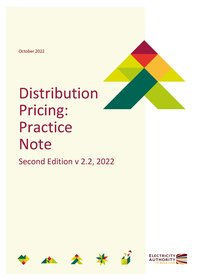Distribution pricing
Efficient distribution pricing helps provide a reliable and affordable electricity supply for consumers. Distributors are required to follow the 2019 Distribution pricing principles, publish their pricing methodology and discuss their pricing plans and progress with us each year.
On this page —
2019 Distribution pricing principles
- Prices are to signal the economic costs of service provision, including by:
- being subsidy free (equal to or greater than avoidable costs, and less than or equal to standalone costs);
- reflecting the impacts of network use on economic costs;
- reflecting differences in network service provided to (or by) consumers; and
- encouraging efficient network alternatives.
- Where prices that signal economic costs would under-recover target revenues, the shortfall should be made up by prices that least distort network use.
- Prices should be responsive to the requirements and circumstances of end users by allowing negotiation to:
- reflect the economic value of services; and
- enable price/quality trade-offs.
- Development of prices should be transparent and have regard to transaction costs, consumer impacts and uptake incentives.
How to apply the distribution pricing principles
Distributors are required to apply the 2019 Distribution pricing principles. These principles set out clear expectations for efficient distribution prices that we use use for our monitoring and assessments.
To understand how to apply these principles, please read and follow our Distribution Pricing Practice Note.
Distribution pricing methodologies
Distribution pricing methodologies are required by the Commerce Commission's Electricity Distribution Information Disclosure Determination.
The Commerce Commission requires every distributor to publish an annual pricing methodology on their website. This needs to describe how distribution prices are calculated, the changes in prices, and the extent to which the pricing methodology is consistent with the above distribution pricing principles.
Our monitoring and evaluation
We've developed a scorecard approach to monitor and comment on distributors’ pricing structures and pricing reform. The scorecards are a basis for regular, constructive engagement with distributors on their price reform aspirations, efforts and roadblocks.
The aim is to highlight good practice, identify weaknesses and gaps, and to suggest opportunities for improvement. We review distributors’ assessments of the:
- current circumstances
- efficiency of price structures
- strategies and implementation of distribution pricing reform
- management of consumer impacts arising from changes to pricing.
Our pricing reform expectations
In May 2024, we sent a letter to distributors setting out our expectations for pricing reform. This letter sets out the following five focus areas for distributors:
- allocating revenue transparently
- assigning all ICPs to time-varying distribution tariffs
- setting peak rates based on a measure of long-run marginal cost
- reducing off-peak and controlled rates
- following up on Asset Management Plan reporting on readiness for increased electrification.
These focus areas are consistent with our Distribution Pricing Practice Note. They outline our expectations for our 2025/26 assessment of distributors' pricing methodologies.
Distribution pricing scorecards
Each year we use distribution pricing scorecards to assess and evaluate distributors’ pricing plans against the 2019 Distribution pricing principles. These assessments draw on information already being disclosed by distributors as part of the Electricity Distribution Information Disclosure Determination.
We update and publish a scorecard for each distributor annually, after they have disclosed their pricing methodologies and roadmaps. We discuss each scorecard with distributors to cover their progress, local context, plans and issues to resolve.
We also publish a summary of distribution pricing scorecards of pricing developments and trends across the sector. Here is the latest summary: Distribution pricing scorecards 2023 - Information paper.
There will be no distribution pricing assessments in 2024. Instead staff resource is focused on the targeted reform of distribution pricing.
A pause of scorecards in 2024 will enable distributors to effectively incorporate the 2024 guidance for 2025/26.
2023 Scorecards
This year most distributors made significant improvements in both pricing methodologies and strategy roadmaps for the challenges of the future.
However, progress for some distributors is not occurring as quickly or comprehensively as we would like. We have identified room for improvement in distributors’:
- application of time-of-use (TOU) peak differentials
- pass-through of transmission charges
- demonstration of quantitative analysis linking network circumstances to peak signal strength, consistent with cost-reflective pricing
- provision of quantitative information on calculating the subsidy-free range (the range between incremental and standalone cost).
Read our information paper with our findings for distributor's scores for 2023.
2022 Scorecards
No distribution pricing scorecard assessments were completed. Instead, we wanted to give distributors time to understand and implement the guidance in our 2022 Distribution Pricing Practice Note.
2021 Scorecards
The 2021 scorecards indicate that most distributors are still not looking hard enough at their own cost drivers, nor properly considering how to design more efficient pricing. Some are making good progress, but others have made little real progress, and for many there appears to be no urgency towards reform.
Northpower, Wellington Electricity and Aurora were the distributors with the highest scorecard scores. Wellington electricity scored well (5/5) in assessment of local circumstances and their roadmap. Aurora scored well (5/5) in assessment of local circumstances, alignment with the principles and strategy. Both Northpower and Aurora scored 4/5 for their consideration of consumer impact.
Given that efficient pricing has significant benefits for consumers, and will enable an efficient transition to a low-emissions economy, we want to see faster reform.
View our summary of findings - Distribution pricing scorecards 2021
2020 Scorecards
The 2020 scorecards show how well each distributor is progressing towards making its pricing more efficient.
The scorecards assess distributors’ published pricing methodology and roadmaps at a point in time.
View our summary of findings - Distribution pricing scorecards 2020
